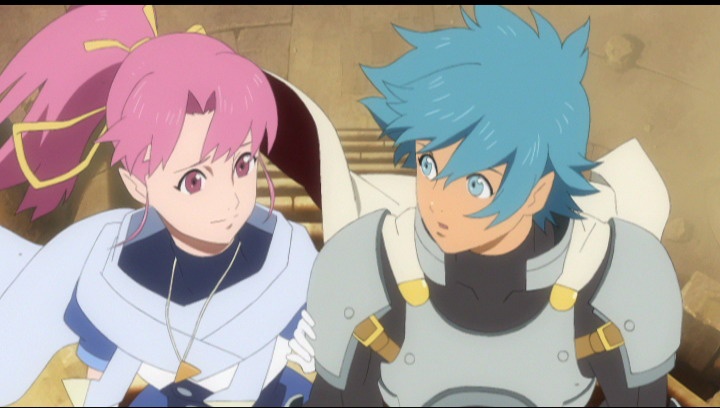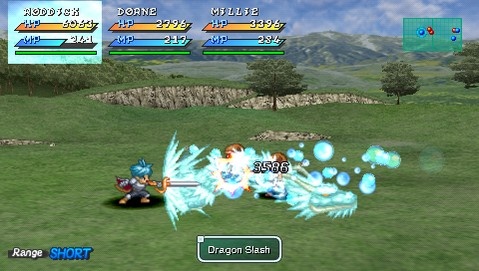Star Ocean: First Departure Hands-On
In this remake of the first installment of the Star Ocean saga, we embark on a journey into space in hopes of preventing a galactic war.
It has been 12 years since the first Star Ocean was released in Japan on the Super Famicon. North American players didn't get a chance to experience this space saga until Star Ocean: The Second Story was released in 1999 on the PlayStation. Since then, we've only seen Star Ocean: Till the End of Time, which sold well enough to encourage Square Enix to revamp the original game that started it all and release it exclusively for the PlayStation Portable. Star Ocean: First Departure, originally developed by Tri-Ace, now has fully animated cutscenes with voice acting to bring this adventure to life.
The opening cinematic is set in space, but after the intriguing events that unfold, the story then takes you to the planet Roak, where a group of friends--Roddick Farrence, Millie Chliette, and Dorne Murtough--are patrolling a small town called Kratus. It seems that normally things are quiet and boring, but suddenly some bandits invade the town, and the trio must fend them off. For the first several hours of our hands-on session, we weren't able to spend much time in space. This doesn't seem like a sci-fi role-playing game at first, until you meet up with a crew from the Terran Federation ship and get a chance to go aboard their ship, Star Trek-style. Without revealing too many plot points, the story is engaging so far, and you'll find yourself pushing forward to see what happens next.

Real-time combat keeps the pace of the game moving quickly, and most battles we've come across end in less than a minute. The leveling is well paced as well, and the only time we had any difficulties was when we wandered into an area that was clearly designed for us to return to later in the game. Fights are random, and when they occur, you're brought into a 3D battlefield where you have full control of one character and can run around and slash at enemies with the X button. During the fight you can switch to any character in your party and have full control over that character by hitting the circle button. Special art (abilities) can be mapped to the L and R buttons so that you can unleash more-powerful attacks. When you're not in a fight, you can adjust the strategy of your party in your menu so that the computer-controlled members can be more aggressive, stay on the defensive, save their special skills, or spread out and attack, depending on the situation. The formation of the party can also be adjusted so that when you enter a fight, you can have some characters farther back so they can heal, and you can have the fighters closer to the enemies so they can get to them quickly.
When you're on the overworld map, there is a smaller map in the corner to indicate where you are, and red dots will highlight what points of interest are around you. The world feels huge, which makes it a bit disorienting. The L and R buttons can be used to rotate the camera angle, but if you're watching the little map in the corner, a red arrow will let you know which direction you're facing. There are no maps in the dungeons, which isn't a problem since it'll encourage you to explore. When you're right outside of a town, sometimes a private action notification will appear so that when you hit the square button, a short dialogue sequence will occur between your party members. This can be skipped, but it provides some insight to certain characters and adds to the story.
Instead of just leveling and getting stronger, each time you level you also gain skill points, which can be spent toward customizing your character with different skill sets. You have to first purchase skill sets from a skill guild in town. Once you do, you'll be able to use your points to either raise a character's ability in battle or have him or her learn a new a craft. Characters have their own talents, which should be taken into account when you decide which craft to teach them. For example, Roddick has a talent when it comes to taste; you would hope this would help him be a better cook. When you put skill points toward the skills of knife, recipe, and keen eye, he will have learned the cooking specialty and can then create items from raw ingredients. Each time you put skill points toward a skill, the skill will level, until a maximum of 10. Once you have multiple specialties at your disposal, there are super specialties that can be performed by combining specialties from several characters. This system is a cool distraction because you'll find a lot of raw material out in the field and you can use your character to try to transform it into useful items. It doesn't always work properly, however; we made our fair share of stinky bean cakes and rotting fish before making an item that was worth something. When cooking does work, you'll create items that can be used to restore hit points and magic points.

The animated cutscenes were done by Production I.G, a company that has worked on multiple anime films and television series, including the TV series Ghost in the Shell. As you progress through the game, the cutscenes can be viewed again from the main menu via the movie gallery. The in-game graphics are also well done, especially the towns because a lot of detail and realism have been added to the structures. It makes your blue-haired sprite-like hero stand out against a more subtle backdrop, but at least treasure chests and townspeople are easy to spot. Fans who enjoyed the look and feel of sprites before RPGs moved toward more-realistic 3D character models will be happy with what First Departure has to offer. The music by Motoi Sakuraba will also not disappoint. His score includes some charming melodies to portray the right setting as well as sci-fi-inspired themes to go along with the story. The opening Japanese vocal theme is catchy and grows on you after a couple of listens.
Star Ocean: First Departure plans to set the stage for what's to come. Role-playing game fans that haven't yet experienced a Star Ocean game should start here if they want to immerse themselves in this franchise. Star Ocean: Second Evolution will be available right around the corner early next year. In the meantime, look for First Departure when it hits store shelves October 21.
Got a news tip or want to contact us directly? Email news@gamespot.com
Join the conversation